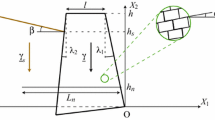Abstract
The assessment of existing structures and infrastructures is a primary task in modern engineering, both for its key economic significance and for the extent and the significance of the built environment, nonetheless operational rules and standards for existing structures are often missing or insufficient, especially for masonry constructions. Existing masonry buildings, even in limited geographical regions, are characterized by many masonry types, differing in basic material, mortar, block shape, block texture, workmanship, degree of decay and so on. For these reasons, relevant mechanical parameters of masonry are often very uncertain; their rough estimation thus leads to inaccurate conclusions about the reliability of the investigated structure. In this work, a methodology to derive a refined probabilistic description of masonry parameters is first outlined starting from the analysis of a database of in-situ tests results collected by the authors. In particular, material classes, representing low, medium and high-quality masonry, are identified for a given masonry typology by means of the definition of a Gaussian Mixture Model. The probability density functions so obtained are the fundamental basis for the implementation of probabilistic analysis methods. In particular, the study will focus on the evaluation of masonry classes for compressive strength of stone masonry, considering a relevant database of semi-destructive, double flat jacks, in-situ test results. The statistical properties of the identified masonry classes, which can be used for the direct probabilistic assessment of structural performance of masonry walls under vertical loads, are finally considered for the evaluation of suitable partial safety factors, γM, to be used in the engineering practice.
Access this chapter
Tax calculation will be finalised at checkout
Purchases are for personal use only
Similar content being viewed by others
References
Croce, P., & Holicky, M. (2015). Operational methods for the assessment and management of aging infrastructure. TEP: Pisa, Italy.
Domański, T., & Matysek, P. (2018). The reliability of masonry structures—Evaluation methods for historical buildings. Technical Transactions, 9, 91–108.
Sykora, M., et al. (2013). Probabilistic model for compressive strength of historic masonry. In Safety, reliability and risk analysis beyond the horizon (ESREL 2013).
Marsili, F., et al. (2017). A Bayesian network for the definition of probability models for masonry mechanical parameters. In 14th IPW (pp. 253–268). Springer.
Witzany, J., Čejka, T., Sykora, M., & Holický, M. (2015). Strength assessment of historic brick masonry. Journal of Civil Engineering and Management.
EN 1996-1-1:2005. (2005). Eurocode 6—Design of masonry structures. Brussels: CEN.
ASTM, American Society for Testing and Materials. (1991). Standard test method for in-situ measurement of masonry deformability properties using flat jack method. C 1197-91.
Croce, P., et al. (2018). Shear modulus of masonry walls: A critical review. Procedia Structure Integrity, 11, 339–346.
Croce, P., et al. (2020). In situ tests procedures for the evaluation of masonry mechanical parameters. In 4th International Conference on Protection of Historical Constructions, PROHITECH 2020. Athens, Greece (Accepted for publication).
EN 1990:2002. (2002). Eurocode—Basis of structural design. Brussels: CEN.
Henzel, J., & Karl, S. (1987). Determination of strength of mortar in the joints of masonry by compression tests on small specimens. Darmstadt Concrete, 2, 123–136.
Gucci, N., & Barsotti, R. (1995). A non-destructive technique for the determination of mortar load capacity in situ. Materials and Structures, 28, 276–283.
Croce, P., et al. (2021). Bayesian methodology for probabilistic description of mechanical parameters of masonry walls. ASCE-ASME Journal of Risk and Uncertainty in Engineering Systems, Part A: Civil Engineering, 7(2), 04021008.
Council, I. P. W. (2019). Guidelines for application of Italian building code. Roma, Italy: Istituto Poligrafico e Zecca dello Stato (In Italian).
Borri, A., et al. (2015). A method for the analysis and classification of historic masonry. Bulletin of Earthquake Engineering, 13(9), 2647–2665.
Croce, P., Marsili, F., Klawonn, F., Formichi, P., & Landi, F. (2018). (2018) Evaluation of statistical parameters of concrete strength from secondary experimental test data. Construction and Building Materials, 163, 343–359.
Croce, P., et al. (2020). Statistical parameters of steel rebars of reinforced concrete existing structures. In Proceedings of the 30th European Safety and Reliability Conference and the 15th Probabilistic Safety Assessment and Management Conference, 4751–4757, Research Publishing: Singapore.
Press, W. H., Tevkolsky, S. A., Vetterling, W. T., & Flannery, B. P. (2007). Numerical recipes, the art of scientific computing (3rd ed.). NY: Cambridge University Press.
MacLachlan, G., & Peel, D. (2000). Finite mixture models. New York: Wiley.
Luechinger, P., et al. (2015). New European technical rules for the assessment and retrofitting of existing structures (Joint Research Center (JRC) 94918 Report).
Fédération internationale du béton (fib) Bulletin 80. (2016). Partial factor methods for existing concrete structures. Germany: DCC, Siegmar Kästl e.K.
Vrouwenvelder, T., & Scholten, N. (2010). Assessment criteria for existing structures. Structural Engineering International, 20(1), 62–65.
Sykora, M., & Holicky, M. (2012). Target reliability levels for the assessment of existing structures—Case study. In Proceedings of IALCCE 2012, Vienna, Leiden: CRC Press/Balkema.
Author information
Authors and Affiliations
Corresponding author
Editor information
Editors and Affiliations
Rights and permissions
Copyright information
© 2021 The Author(s), under exclusive license to Springer Nature Switzerland AG
About this paper
Cite this paper
Croce, P., Beconcini, M.L., Formichi, P., Landi, F., Puccini, B., Zotti, V. (2021). Evaluation of Partial Safety Factors for the Structural Assessment of Existings Masonry Buildings. In: Matos, J.C., et al. 18th International Probabilistic Workshop. IPW 2021. Lecture Notes in Civil Engineering, vol 153. Springer, Cham. https://doi.org/10.1007/978-3-030-73616-3_25
Download citation
DOI: https://doi.org/10.1007/978-3-030-73616-3_25
Published:
Publisher Name: Springer, Cham
Print ISBN: 978-3-030-73615-6
Online ISBN: 978-3-030-73616-3
eBook Packages: EngineeringEngineering (R0)




